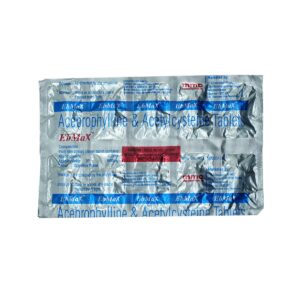CYSTEINE + ACEBROPHYLINE
Cysteine: Cysteine is a non-essential amino acid that is commonly used as a supplement. It is also a component of hair, skin, and nails, and plays a crucial role in protein synthesis and detoxification processes in the body.
One of the main uses of cysteine is as a mucolytic agent, helping to break down and thin mucus in conditions such as chronic bronchitis, asthma, and cystic fibrosis. It can be administered orally, intravenously, or inhaled as a solution or aerosol.
The mechanism of action of cysteine as a mucolytic agent is largely attributed to its ability to break disulfide bonds within mucus proteins, leading to a loosening and thinning of mucus secretions. This makes it easier for individuals to clear their airways.
The recommended dose of cysteine for mucolytic use varies depending on the formulation and mode of administration. Orally, typical doses range from 200 to 600 milligrams per day. Intravenous doses may range from 0.6 to 1.2 grams per day. Inhaled cysteine solutions or aerosols are administered in dilutions ranging from 1-10% concentration, with recommended dosing dependent on the specific product being used.
Like any medication, cysteine may have side effects. Common side effects include nausea, vomiting, and gastrointestinal discomfort. Rarely, severe allergic reactions can occur, characterized by symptoms such as rash, itching, swelling, dizziness, and difficulty breathing. In such cases, medical attention should be sought immediately.
It is important to note that while cysteine is generally considered safe for most individuals, it is always advisable to consult with a healthcare professional before starting any new supplement or medication to determine the appropriate dosage and to evaluate potential interactions with other medications.
Acebrophyline: Acebrophylline is a mucolytic drug commonly used in the management of respiratory disorders such as chronic obstructive pulmonary disease (COPD) and bronchial asthma. It is available in the form of tablets, capsules, and syrups.
The mechanism of action of Acebrophylline involves two components: theophylline and ambroxol. Theophylline acts as a bronchodilator by relaxing the smooth muscles of the airways, making it easier for the individual to breathe. Ambroxol is a mucolytic agent that helps in thinning and reducing the viscosity of mucus, thereby making it easier to expel from the respiratory tract.
The recommended dose of Acebrophylline varies depending on the severity of the condition and the patient’s age. Generally, for adults, a starting dose of 100 mg is prescribed twice daily. The dosage can be adjusted by a healthcare professional based on the individual’s response. For children, the dose is lower and is determined based on their body weight.
Common side effects of Acebrophylline include nausea, vomiting, gastrointestinal disturbances, headaches, dizziness, and skin rashes. These side effects are usually mild and resolve on their own. However, if any severe or persistent side effects occur, it is important to seek medical attention immediately.
It is important to note that Acebrophylline may interact with other medications, such as certain antibiotics, antacids, and cardiac drugs. Therefore, it is important to inform your healthcare provider about any other medications you are taking before starting Acebrophylline.
In conclusion, Acebrophylline is a mucolytic drug that is commonly used for the management of respiratory disorders. It acts by both relaxing the airway muscles and thinning the mucus, making it easier to breathe. It is generally well-tolerated but may cause mild side effects. The dosage and duration of treatment should be determined by a healthcare professional based on the individual’s condition and response to the drug.

